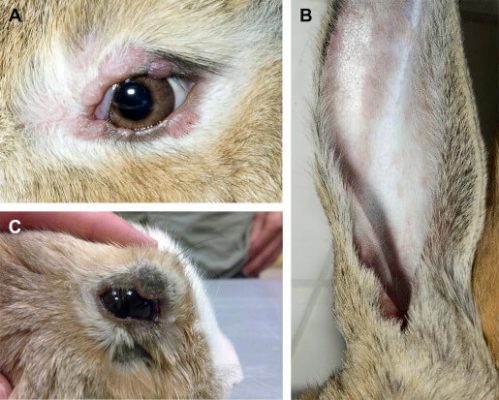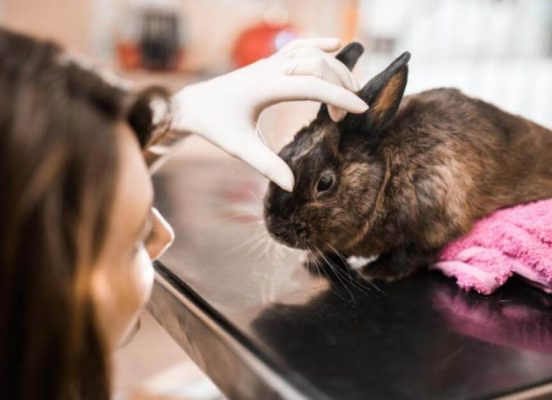Shope Papilloma Virus
Shope Papilloma Virus (SPV) is a type of virus that causes the formation of papillomas, or warts, on rabbits and other small mammals. The virus was initially identified in 1933 by American virologist Richard E. Shope, who bears his name.
Despite the fact that SPV is not known to damage humans, it may be a major issue for farmers and other people who interact with small animals.
Table of contents
Causes and Transmission
Causes of Shope Papilloma Virus
Shope Papilloma Virus is caused a type of virus called a papillomavirus. A family of DNA viruses known as papillomaviruses is responsible for the development of warts and papillomas on the skin and mucous membranes. The papillomaviruses that infect many animals, including humans, come in a wide variety.

How the Virus is Transmitted
Direct contact with infected animals or contact with contaminate things, such as cages or food bowls, is how the Shope Papilloma is spread. Infected animal scratches or bug bites may potentially transmit the virus.
Risk Factors for Contracting the Virus
People who work with rabbits or other small mammals are at higher risk of contracting Shope Papilloma Virus. In places like farms or animal shelters where there are many of rabbits, the virus is more prevalent.
Symptoms
Common Symptoms of Shope Papilloma Virus
The development of warts or papillomas on the skin or mucous membranes is the Shope Papilloma most typical symptom. Small, large, flat, or raised warts are all possible. Although they can happen anywhere on the body, they usually do on the head, face, and ears.

How the Virus Affects the Body
The skin and mucous membranes of small animals are impact by the virus. Warts or papillomas may develop as a result of the virus’s improperly causing the cells in the afflicted region to expand. In extreme situations, the warts may become huge and obstruct the animal’s ability to breathe, eat, or drink.
Severity of Symptoms
The severity of symptoms of Shope Papilloma Virus can vary depending on the strain of the virus and the health of the animal.
The warts may sometimes be minor and not bother the animal. In other instances, the warts can be huge and uncomfortable for the animal or get in the way of its ability to breathe, drink, or feed.
Diagnosis and Treatment
Common Treatment Options for Shope Papilloma Virus
| Treatment | Description | Pros | Cons |
| Surgical removal of warts | Surgically removing the warts or papillomas from the skin or mucous membranes | Effective in removing warts | Can be costly, may require anesthesia and multiple procedures |
| Cryotherapy | Freezing the affected tissue with liquid nitrogen | Non-invasive, can be done quickly | May require multiple treatments, can be uncomfortable for the animal |
| Topical medications | Applying medications directly to the affected area | Non-invasive, can be used for multiple warts | May take time to see results, may require multiple treatments |
| Immunomodulators | Stimulating the immune system to fight the virus | Can be effective in reducing the number of warts | May have side effects, not always effective |
| Laser therapy | Using a laser to destroy the warts or papillomas | Non-invasive, can be done quickly | May be expensive, may require multiple treatments |
The Shope Papilloma Virus treatment options shown in this table are some of the most popular ones. The advantages and disadvantages of each treatment method are discuss so that readers may choose the one that could be best for their cat.
How Shope Papilloma Virus is Diagnosed
Examining the warts or papillomas on the skin or mucous membranes of the infected animal may identify the virus. To confirm the diagnosis, a veterinarian could perform a biopsy on the afflicted tissue.

Treatment Options for the Virus
There is no cure for Shope Papilloma Virus. To control the virus’s symptoms, there are numerous therapeutic options available. These consist of:
- Surgical removal of the warts or papillomas
- Cryotherapy (freezing) of the affected tissue
- Topical medications to reduce the size and number of warts
Effectiveness of Treatment
The kind of medication employed and the intensity of the symptoms affect how well the Shope Papilloma Virus is treated. In certain instances, the animal may need to have the warts or papillomas surgically removed in order to feel better.
Multiple treatments might be require, but cryotherapy and topical medications may also be effective in reducing the size and number of warts.
Prevention
Preventative Measures for Avoiding the Virus
Preventing the spread of Shope Papilloma Virus involves taking several precautions. These include:
- Washing and sanitizing cages, food bowls, and other small animal equipment on a regular basis.
- Fresh animals being quarantine for a few weeks before being introduce to existing populations
- Limiting interactions between animal populations
- Avoiding wild rabbits and other tiny creatures in the wild

Vaccinations Available for Shope Papilloma Virus
There are currently no vaccines available for Shope Papilloma Virus. However, scientists are working to create a vaccine that might stop the virus from spreading among populations of rabbits.
The Importance of Prevention
There are a number of reasons why it is crucial to stop the spread of the Shope Papilloma Virus. First, tiny animals may have severe pain and health issues as a result of the infection.
Second, there is a high likelihood that the virus will spread quickly to other animals in the same community, resulting in large outbreaks. The Shope Papilloma Virus may also be a serious issue for farmers and other people who deal with small animals, resulting in losses in income and other issues.
Research and Future Developments
Current Research on Shope Papilloma Virus
Researchers are currently working on developing a vaccine that could prevent the spread of Shope Papilloma Virus among rabbit populations.
More effective viral therapies are being develope, and research is also being done to comprehensive how the virus spreads throughout animal groups.
Potential Future Developments in Treatment and Prevention
The development of new vaccinations and other prevention measures for the Shope Papilloma Virus is a possibility in the future.
It’s also conceivable that scientists may learn new details about how the virus spreads through animal populations, providing the basis for improved preventative methods.
The Outlook for Those Infected with Shope Papilloma Virus
For small mammals infected with Shope Papilloma Virus, the outlook depends on the severity of the symptoms and the effectiveness of treatment.
Surgery, cryotherapy, or topical medicines may usually be used to treat warts or papillomas. To control the symptoms, the infection may, nevertheless, be chronic and need for continued care.
Youtube Video About Shope Papilloma Virus
Final Thought
Shope Papilloma Virus is a type of virus that causes the formation of warts or papillomas on the skin or mucous membranes of rabbits and other small mammals.
Although the virus is not harmful to humans, it can seriously harm animals, which poses a serious risk to farmers and other people who handle small mammals.
It is feasible to control the spread of the Shope Papilloma Virus and lessen its effects on animal populations by creating novel therapies and preventive tactics.
You May Also Like
Protecting Your Child During a Virus Epidemic
The Pandemic: Is it Really Over?
FAQ
Shope Papilloma Virus has no cure, however numerous treatments may control its symptoms. These include surgical removal, cryotherapy (freezing), immunomodulators, topical medications, and laser therapy. Wart kind and intensity determine therapy. To choose the finest pet therapy, see a vet.
Cleaning and sanitizing rabbit cages, food bowls, and other small animal equipment routinely helps prevent papillomatosis. Before introducing new animals to existing populations, quarantine them for several weeks and limit their contact. Avoid wild rabbits and other tiny animals too. Rabbit papillomatosis vaccines are unavailable.
Infected animals or contaminated things like cages or feeding bowls spread Shope Papilloma Virus. Insect bites and animal scrapes may transmit the infection. Working with rabbits or other small animals increases Shope Papilloma Virus risk.
No virus causes jackalopes, which are fictional. The jackalope, a jackrabbit-antelope hybrid with deer antlers, is a Western folklore. The story may have come from misidentified bunnies or taxidermy.
Papilloma removal is usually safe. To rule out more severe conditions, papillomas should be evaluate by a doctor. Papilloma removal depends on its location, size, and patient condition. Surgery, cryotherapy, or topical medicines may remove it.





